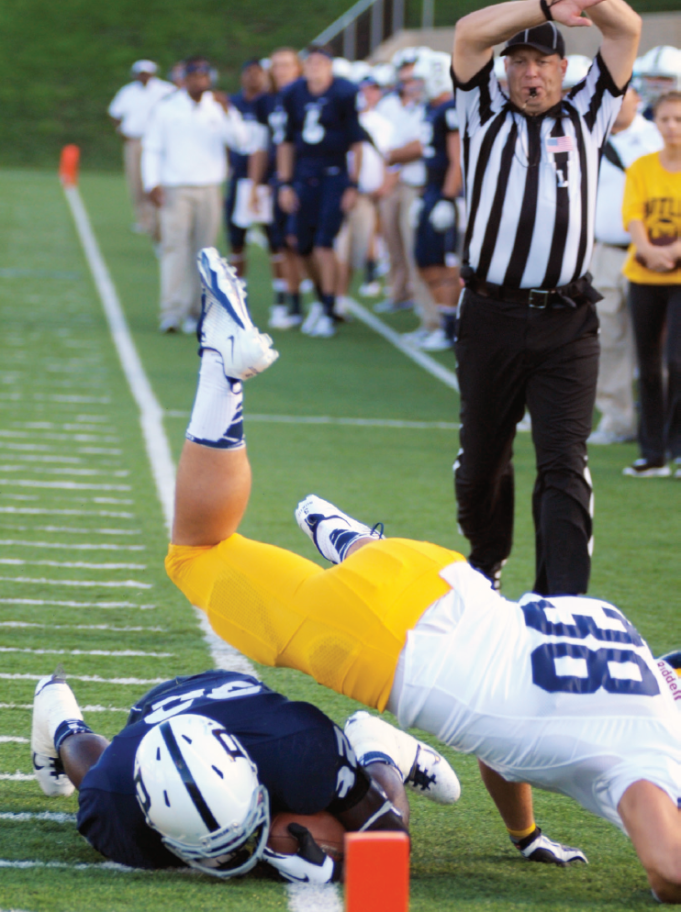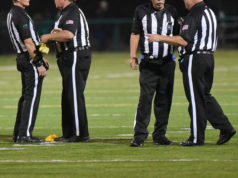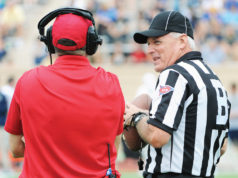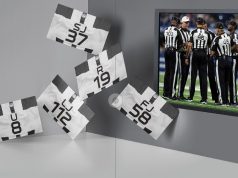By Gerry Grunska
Recently I witnessed a victory that was essentially accomplished through timing errors by the officials. The process went like this. Time was running out for team A, no timeouts left, ball on team B’s 40 yardline. A 20-yard pass to team B’s 20 yardline, caught near the sideline, gave team A a first down with about five seconds left. The line judge stopped the clock for the first down and relayed the ball to the back judge, who flipped it to the umpire for placement at the hash. The play had ended, however, about a yard inside the field of play. The clock should have been restarted, but it wasn’t. The referee assumed the play had carried out of bounds. Hence, team A huddled, lined up and completed another pass in the end zone for the winning score as time expired.
How did that happen? Because there was no communication between the line judge and the referee about the status of the clock. Nor did any other crewmember insert himself into the situation to verify clock status.
If the clock had been started properly on the ready, it is unlikely that team A would have been able to run a play. Even lining up and spiking the ball would have been impossible. I know all that because I saw it from the press box; I had been assigned to observe the crew.
Miscommunication about the clock happens a lot in prep games.
I know I had my troubles when I formed a crew back in the Midwest several decades ago. The problem was getting officials to kill the clock before reporting live-ball fouls. They were so anxious to report their violation that they just made a spirited dash to me and stuttered through their description, puffing excitedly. They were relatively new officials.
I quickly adopted a sure-fire technique. Before they uttered a word, I’d say, “Have you stopped the clock?” Often, I’d get “Oops, no” for a reply, but before long I had them trained.
I resorted to insisting that they wave twice. If they forgot, I’d chide them gently afterward. Also, some contest timekeepers notified me of missed signals. So I decided that when one person killed the clock, we’d all echo it. The pros do it, I asserted; there’s no reason why we can’t be unified in compliance. It paid off at the end of games when time was critical.
The manual says to kill the clock and blow the whistle repeatedly when the ball is dead if you’ve thrown the flag for a live-ball foul. (The same goes for a dead-ball foul, even if the clock isn’t running.) That alerts fellow officials and the timer that you’ve called a foul. It’s a simple directive, but from my observation a lot of officials don’t follow it.
It is fundamental that officials handle the clock properly. It is simplistic to say they are responsible for timing of the game, but crews don’t often put much emphasis on the topic. When was the last time your crew chief introduced the topic of timing procedures in a pregame conference? In some measure that is a trick question. A better query might be: Has the notion ever come up?
I was at a game last year where the referee committed seven timing mistakes. Frankly, they were of no consequence in terms of the game’s outcome — they occurred in the middle of a quarter — and as far as I could tell the blunders went unnoticed by coaches and players. They were also ignored by crewmembers, because the commander of the crew handled matters on the field basically by himself.
There were three situations when a pre-snap violation — two false starts and a defensive encroachment — occurred immediately after a change of possession. In each case the referee started the clock after the penalty walkoff, even though the clock had not been activated after the kick return or interception.
One time the referee lingered near the sideline to answer a coach’s question after a play. The clock continued to run for a half-dozen seconds until the referee went back to his position and chopped the ready.
Another time the referee stopped to warn a defensive player at the succeeding spot while the clock was in motion. Again, probably fewer than 10 seconds went by before the referee retreated and signaled the ready.
Later a play took place near the bench in which a discussion followed between the referee and two crewmembers. Evidently there was some confusion about whether a fumble had occurred. When he went back to his post, the referee wound the clock. But it had never stopped throughout the conference. No one had the presence of mind to kill it.
On my own crew I insisted the wing official who had covered a sideline play flash me a signal, along with the ball relay, about clock status. One index finger twirled in front of the belt indicated a live clock, and two fingers wiggled at the waist meant that the clock should remain dead. Those were unobtrusive but clear indicators.
In football you must deploy signals. In the situation described at the start of this article, the crew had been dealing with a lackadaisical line judge the entire game. Sometimes he wouldn’t stop the clock on first downs. His crewmates did it instead. When he did signal, it was a wearying flop of his arms, desultory, nonchalant, almost as though he were doing it reluctantly.
I have seen that before. Officials know they have to kill the clock and they execute a half-hearted wave, sometimes not even crossing the arms overhead. Here’s a vote for emphatic swipes. Let the timer know you mean business. Also, repeat your action to the referee. Let him know whether the clock should be restarted or remain dead. And if you use a finger whistle, don’t give onehanded kill-the-clock signals.
Since I’ve retired from the field I have sometimes been a clock operator in the booth. Seldom does a game move to the finish line without a call from the field for a clock adjustment. It looks to me like inattentiveness, and I can almost anticipate it just before a half. That’s when coaches, players and spectators are keeping their eyes on the timepiece. A penalty enforcement while the clock is running in the first quarter can readily go unnoticed. Nobody is paying attention or cares. The referee may be taken aback, though, when he winds his arm and finds the clock already ticking away.
When a runner moves out of bounds it is incumbent upon the covering official to kill the clock, waving his arms above his head.
Trouble is, sometimes the timer in the press box may not see the signal. Why? Periodically there are numerous players clustered in the vicinity and that scrum hides the covering official. That is particularly evident when the runner is driven from the field near a team bench, especially the bench opposite the press box.
Sometimes the official at the sidelines covering the play bends over to peer at the action beyond the sidelines while attempting to stop the clock, and I can’t see his arms clearly. Sometimes he executes a cursory signal, floppy or halfhearted, perhaps even without crossing his arms overhead.
An official killing the clock should do so with meaning, so that his purpose is clearly understood. At times, when I’ve been a clinician, I’ll have the attendees rise and go through signals: touchdowns, false starts, changes of possession, even throwing the flag. It’s surprising how sloppy many people are. You wouldn’t think that killing the clock required such a defined skill, a firmly conscious effort.
What's Your Call? Leave a Comment:
Note: This article is archival in nature. Rules, interpretations, mechanics, philosophies and other information may or may not be correct for the current year.
This article is the copyright of ©Referee Enterprises, Inc., and may not be republished in whole or in part online, in print or in any capacity without expressed written permission from Referee. The article is made available for educational use by individuals.



















